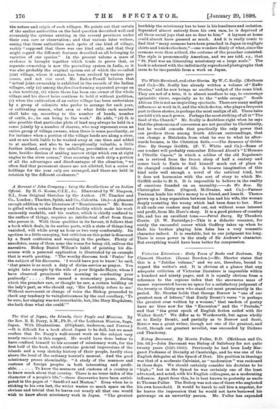CURRENT LITERATURE.
The Indian Village Community. By B. H. Baden-Powell, M.A., C.I.E. (Longmans and Co. 16s.)—This exhaustive and rather laborious treatise is written to disprove the theory that there was one original type of village community in India,—namely, that of a group of persons owning the land of the village in common or collectively. The author shows that Sir Henry Maine must have written on this subject without having before him distinc- tive evidence, such as has since been obtained, of the widespread existence (namely, over about three-quarters of the whole area of India) of a type of village in which the separate holders never represented co-sharers in a unit estate, nor acknowledged any form of common ownership. Even where joint villages exist, Mr. Baden-Powell shows that there are important differences in the nature and origin of such villages. He points out that certain of the earlier authorities on the land question described well and accurately the systems existing in the several provinces under their own care or observation ; and that various later writers, seeing that these authorities each spoke of one kind of village, rashly " supposed that there was one kind only, and that they might regard the different features described RS all belonging to varieties of one species." In the present volume a mass of evidence is brought together which tends to prove that, as separate ownership is now the prevailing system in India, so it was also probably the original system out of which the so-called joint village, where it exists, has been evolved by various pro- cesses, and not vice vexed. Mr. Baden-Powell believes that "actual joint-ownership is exhibited in the records of the Indian villages, only (a) among the/amities forming separated groups on a clan territory, (b) where there has been one owner of the whole village and his direct heirs continue to hold it without partition, (c) when the cultivation of an entire village has been undertaken by a group of colonists who prefer to arrange for each year, or cultivating season, what area or what fields each member shall take up, according to the number of hands, number of cattle, &c., he can bring to the work." He adds, "(d) It is also possible that particular plots of land may always be held in a sense jointly by a number of sharers, who may represent even an entire group of village owners, when there is some peculiarity, as for instance when a portion of the village lands are along a river, and so are both liable to be washed away at one time and added to at another, and also to be exceptionally valuable, a little further inland, owing to the unfailing percolation of moisture ; here, besides devices of making narrow strips which run at right angles to the river course," thus securing to each strip a portion of all the advantages and disadvantages of the situation, "we often find that permanent shares are not allotted, but a series of holdings for the year only are arranged, and these are held in rotation by the different co-sharers."



















































 Previous page
Previous page